Foundation for Rural & Regional Renewal (FRRR)
FRRR and Paul Ramsay Foundation (PRF) are pleased to announce a multi-year partnership to support Community Led Climate Solutions in remote, rural and regional communities experiencing disadvantage across Australia.
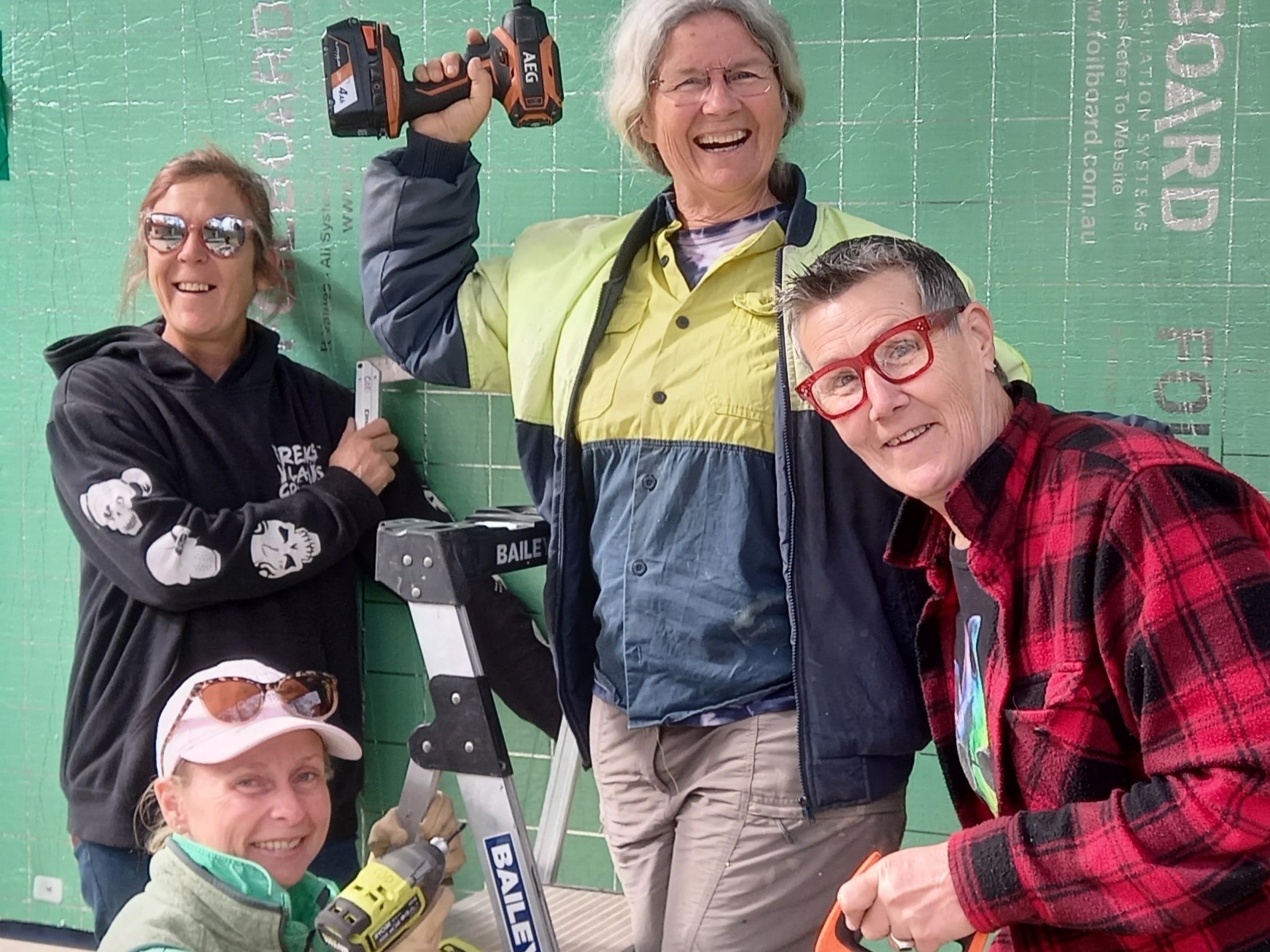
This support aims to address disadvantage, reduce the risks and impacts of climate change on community lives and livelihoods and enable community-led solutions. Funding will be distributed through FRRR’s Community Led Climate Solutions grant program.
Natalie Egleton, FRRR’s CEO, said that with rural communities disproportionately impacted by the impacts of climate change, it is vital that there is flexible funding to seed and strengthen the activities of not-for-profit organisations leading change in their communities.
“We know remote, rural and regional communities are already feeling the impacts of a changing climate and many are ready to respond – but what that looks like in their community will differ depending on their context. The support of Paul Ramsay Foundation is important to back the initiatives of locals who will act on climate solutions and make a difference in their community.
“With Paul Ramsay Foundation’s support, combined with generous support of organisations such as Boundless Earth and Hand Heart Pocket Foundation, we are looking forward to continuing to provide this valuable support annually through a dedicated grants and support program.”
Liz Yeo, Chief Alliances Officer at Paul Ramsay Foundation, said, “At PRF, we recognise that communities themselves bring great strengths and ideas about how best to tackle the challenges they face. We’re pleased to be joining with FRRR to support remote, rural and regional communities to develop local solutions to the impact of climate change and socioeconomic disadvantage.”
Round 2 of Community Led Climate Solutions will open mid-July 2024. Subscribe to FRRR’s eNews to receive a monthly update about the grants and opportunities on offer.
The partnership between the Foundation for Rural & Regional Renewal (FRRR) and the Helen Macpherson Smith Trust (HMST) highlights the value of grassroots-focused capacity building in community development.
We are pleased to bring you a Q&A featuring Debra Morgan, an accomplished leader with two decades of executive experience in the philanthropic and for-purpose sectors. Debra joined HMST in October 2021 and has been instrumental in shaping and delivering philanthropic programs that make a meaningful difference.
HMST made a substantial donation to FRRR’s Bushfire Recovery Fund, developed innovatively with further collaboration with the Sidney Myer Fund (SMF). This Fund was developed to meet a gap in the funds being made available to Victorian communities affected by the 2019/20 bushfires, which was building the capacity of organisations in those communities to address challenges in their operations, supporting their growth and development to enable their continued support of their communities’ recovery.
Breaking away from traditional grant structures, the program employed community consultation to identify backbone organisations for multi-year funding. Over three years, the Program Advisory Committee, featuring Debra Morgan, guided the program, and in November 2023 the grant program awarded the final multi-year grants to 9 organisations across North East Victoria and East Gippsland. The recipients represent a broad range of organisations from Indigenous-led initiatives to neighborhood centres. As these projects unfold over the next 24 months, FRRR and HMST’s collaboration serves as a powerful example in the philanthropic community.
Watch the video or read the Q&A text to hear Debra Morgan shed light on the intricacies of this impactful partnership.

Tell us about Helen Macpherson Smith Trust and your giving strategy?
We have a strategy which is focused on community resilience and place-based education. We’ve moved from a really broad giving strategy; we were funding in a lot of different areas, and we felt that we really wanted to be able to understand our impact. So we’ve moved to two areas of impact: community and education. And we’re supporting FRRR through our community resilience lens.
What’s unique about the Bushfire Recovery Fund and what did Helen Macpherson Smith Trust set out to achieve with it?
When the bushfires hit in Victoria, trustees really wanted to help the communities and to make a difference. But we understood that an immediate grant may not be the best response, and that communities, while they were dealing with the immediate trauma of the fires might not be best placed to understand their future path. And so through FRRR and with the Sidney Myer Fund, we held hands, and we navigated to the Bushfire Recovery Fund, which is about enabling FRRR to work deeply with bushfire affected communities to understand their needs, and their readiness to receive funds to create a better future for those communities.
What does the Helen Macpherson Smith Trust and co-funder the Sidney Myer Fund see as the strengths of the partnership?
Some of the highlights of the Bushfire Recovery Fund and working so closely with FRRR and the Sidney Myer Fund on this project has been understanding community voices through FRRR and from the community directly.
FRRR plays an amazing role – really working deeply with communities to understand needs, and I credit them with the work that they do on the ground with communities to help them navigate – often complex – granting regimes that we impose as funders, and to understand how we can practically make a difference.
We’ve had the opportunity at Helen Macpherson Smith Trust to meet some of those fantastic community members along the way. We’ve traveled to Mallacoota and met the community health team there we traveled to Sarsfield out of Bairnsdale to see and meet with the community organisation there. And those people are changing their communities – they’re the coalface and they’re making lives better for their community members, and it’s so inspiring to see them. We couldn’t do that without the support of FRRR and without FRRR working on the ground. So we’re really grateful. That’s been absolutely a program highlight for me.
Can you tell me more about how about your partnership and working with the FRRR team?
We’re a really tiny team at Helen Macpherson Smith Trust and we’re based in Melbourne. So one of the great things about FRRR is that there’s people on the ground in rural and regional communities – not just around Victoria but around Australia, and we really see the benefit of that. We feel we can get scale across Victoria through partners like FRRR because of the really deep work that’s happening on the ground. I think that’s one of the rich and wonderful things about FRRR.
Are there any other philanthropic activities and partnerships that you can tell us about?
Through our education focus area we’re funding some really fantastic place-based organisations. We’re funding the Mornington Peninsula Foundation for the education work they’re doing. We’re funding Tomorrow Today Foundation, which is a community foundation in Benalla, again, we’re seeing education outcomes through that project. And we’re also supporting Ganbina in Shepparton – a place-based education project working with Indigenous partners in Shepparton and the region.
Do you have any advice for any philanthropic organisations or other individuals, when choosing who to partner with?
I think the most important thing, when looking at partners to support is the relationships. And we’ve really got a strong relationship with FRRR. We have a long standing relationship with FRRR, and we’re really seeing the benefits of that, and holding hands on the journey, and learning as we go. I see FRRR absolutely as a partner in this – not as a grantor -grantee relationship. We are partners, and I think we’ve really achieved a lot through this project.
In this quarter’s update for FRRR’s partners and supporters, we’ve featured an East Gippsland project that provides a clever resource for community recovery, and you’ll find an interesting conversation with a new supporter in the climate solutions space, Hand Heart Pocket – which is the charitable arm of the Queensland Freemasons.
Also in this edition:
- Insights from FRRR’s team as we network, travel and deliver programs
- Our Progress – Q1 FY 2023/24
- Learn about Fundraising Accounts from OurSchool’s Caroline Milburn
- Details of all our latest reports and thought pieces.
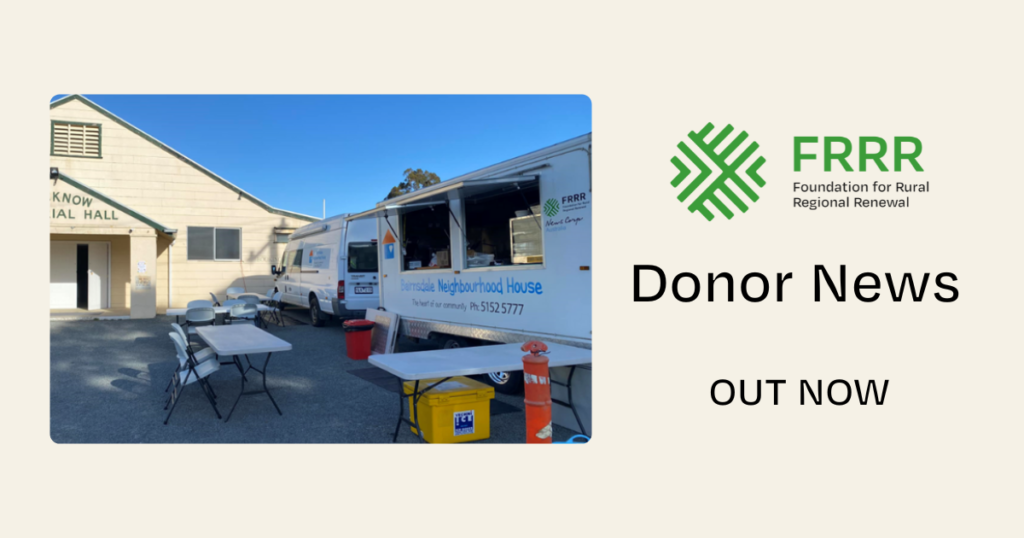
For philanthropic foundation Hand Heart Pocket – The Charity of Freemasons Queensland – creating stronger futures for rural QLD communities through impactful partnerships is key.
With a strategic focus on driving climate solutions at a community level, Heart Hand Pocket has partnered with FRRR to deliver a program that focusses on building resilience and enables grassroots action on climate adaptation.
Sara Parrott, CEO of Hand Heart Pocket, explains why community is at the core of everything they do and how partnerships aligned with purpose create better outcomes and opportunities for everyone.
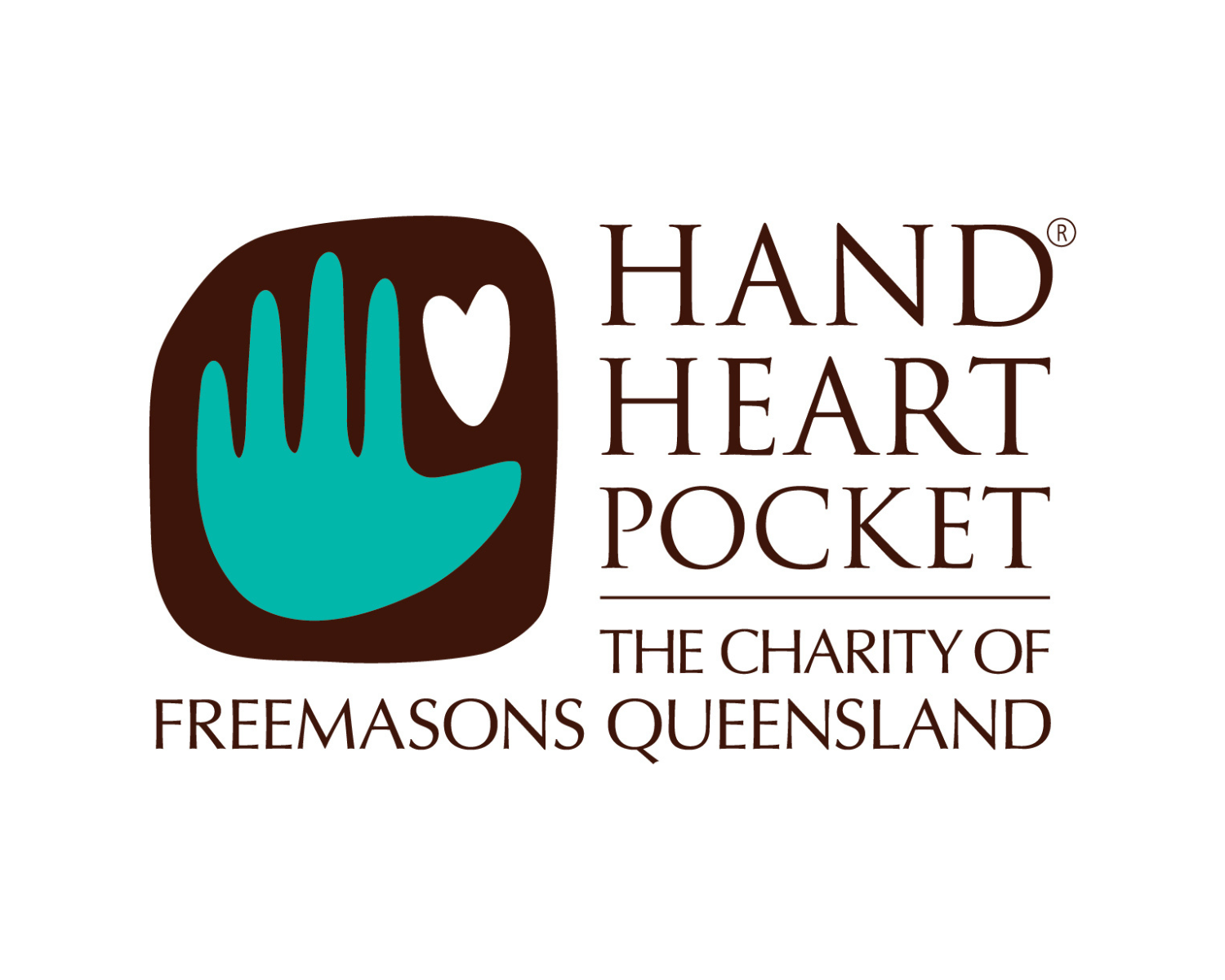
Tell us a little bit about Hand Heart Pocket, its background and how you have designed your giving strategy.
Hand Heart Pocket is the charity of the Freemasons of Queensland. With a history of over 110 years of community work, it was first incorporated in the 1970s. Today, we operate as a philanthropic foundation. We manage an investment portfolio of financial assets that has been built up over the last 100 years by the Freemasons, and that’s money put aside for the benefit of the community. We manage that portfolio and do two things – we do philanthropy from the income and we also do social impact investing with our capital, as well as more traditional responsible investment to earn an income. We’re a relatively small team – there’s about eight of us.
Our purpose is stated as we partner for change for people in need in Queensland and Papua New Guinea. We put that purpose together with lots of thought around the fact that we partner, which means we don’t build things, and we don’t necessarily deliver ourselves, we find great organisations, and great leaders doing things that are very impactful, and we focus on people in need. Our strategic partnerships are focused on young people in need in Queensland, and then we do a range of other things where we support the community more generally, and we also support the members of the Freemasons of Queensland, in their community activity at a local level.
Why do you believe it is important to support remote rural and regional communities in particular?
The Freemasons and Hand Heart Pocket have always been involved in responses to disasters when disaster strikes, and also been a very regionally spread organisation. There are lodges of the Freemasons of Queensland right across the state – there’s about 200. They’re very connected to their local communities. Queensland is the most regionalised of the states – there’s more people living outside of the capital cities in Queensland than any other states. And we really understand the importance of the vibrancy and the sustainability of those communities, for the people who love to live in a more rural setting with more space. It’s really important that we remember that sometimes it’s more difficult to live there. It’s more expensive, the services don’t necessarily reach all the places in Queensland where people love to live. So it’s a combination of where our members are and the heritage of the organisation and also understanding that to sustain healthy and vibrant communities in Queensland. We have to remember that a huge portion of Queenslanders don’t live in the capital city.
Tell us about Hand Heart Pocket’s interest in supporting communities recovering from a preparing for disasters, and also in driving climate solutions?
The board is very forward looking and future focused. And so we understand that an investment in our young people is the best investment that we can make, and that the future that they’re facing is changing quickly. There’s lots of strategic level risks that the community is facing and it could really derail a lot of things about the way that we live our lives and a lot of things that we enjoy. We’ve done some really good risk analysis in our strategy process to understand what climate change will mean, for our organisation and for our members and the local communities. Really, climate change is probably the number one risk. So it, it poses risks to our members and to their communities but it also poses a risk to our organisation from the point of view of what it might do to the assets that we invest in through our investment portfolio and what it might do to in terms of shocks to financial markets, what it might mean for us to have investments that might become stranded assets. So that’s a big part of how we think about it.
And then also, what the possible negative impacts of climate change are on local communities – what it will do to food security, to people’s health, future pandemics, also what it’s going to mean for industries in Queensland. It will have negative impacts on tourism, it will have negative impacts on the Great Barrier Reef. And so there’s lots of communities in Queensland that are facing into very uncertain future.
As a philanthropic foundation, we don’t think about it just in terms of what we give, although it’s embedded into our strategy throughout our relationship with FRRR, but it’s also embedded into our strategy in terms of the way that we invest as well. And we have a responsible investment policy that has an exclusion for new fossil fuels and expansion of fossil fuels. We also have a real focus on investing our money in a way that drives a positive transition, and a sustainable future.
In our giving, we’ve had a historical ability to respond in times of disaster to support communities in Queensland when disaster does strike. We still do that, but we also have a way of giving through FRRR that allows us to invest into what I would call climate adaptation, which is preparation for possible natural disasters and natural hazards like cyclones and floods and fires at a grassroots level. The relationship with FRRR has allowed us to provide a large lump sum of money that FRRR administers and distributes as smaller grants to local grassroots community organisations who are working on all sorts of projects around resilience building in their local community.
We’ve also provided a second round of funding to FRRR to do an additional grant round of small grants that are focused not just on adapting to a potential different future threat from climate change, but also positive action by local communities, to reduce their carbon emissions, and actually mitigate the effects of climate change by changing up their activities in ways that are going to better protect the environment or reduce the carbon emissions. So our response to climate is I suppose weaved through lots of different in different ways through our strategy and the way that we work. And it’s about being future focused, it’s about being really understanding those big system level risks that our community faces. We try really hard to be kind of holistic and really authentic in the way that we address climate.
Tell us more about your partnership with FRRR.
Part of the reason that we’ve partnered with FRRR is because as a philanthropic foundation, we have a small team, and we’re not really geared up to deal with like lots of local communities and do multiple small grants to a large number of organisations across the community.
And so it’s a great partnership for us from that point of view, in that FRRR’s got the expertise, and the relationships across Queensland or across regional and rural communities. And they also have the infrastructure as an organisation to run those grant rounds, which we don’t have. We knew that if we were going to put philanthropic money towards resilience building, that sometimes those small investments, but across a number of different communities can be really, really impactful. We wanted to make sure that the money got down to the grassroots and out to the rural communities, and we didn’t have the capacity to do that. So we were looking for a partner who had the relationships and the internal mechanisms to be able to do it efficiently.
FRRR provides that for us and being able to have a focus on resilience building, and climate adaptation, was what we were looking for. FRRR had the ability and the understanding from a thematic and technical point of view about what those projects would look like in local communities. And then this year, when we came to FRRR saying, we’d like to shift from just disaster response to action on climate, FRRR was really open to that idea, and worked with us to develop the climate solutions grand rounds, so that that extra money could be focused on that as a very specific issue and a specific set of responses from local communities. Again, we didn’t have the infrastructure internally and the people to run those grant rounds and to be able to connect to local communities that we really love the fact that if FRRR already has all that. Our purpose is partnering for change, so we like to work with other organisations, and to be more efficient in the way that we give by joining together with other organisations who are already doing really good work.
Can you tell us a little bit about Hand Heart Pocket of philanthropic activities and partnerships?
There’s an interesting partnership that’s kind of complementary to the work that we do with FRRR. We also have a partnership with GIVIT. Being a Queensland organisation, we know that there’s going to be disasters during and things happening to communities during the summer, which is really unfortunate, but it happens almost every year.
So, in anticipation of that we have a placeholder in our budget for what we might be able to give to disaster. If disaster strikes, we already have a relationship set up with GIVIT where we can respond quite quickly, and we can give them funding and then they distribute that to people in need in local communities. And that’s actually through grassroots organisations. They’re a fantastic partner because they complement what we do with FRRR – so if we want to give immediate disaster relief to GIVIT, which is immediate and small amounts for things like emergency accommodation and replacement of furniture, and then, at the end of the year, if we have some budget put aside for FRRR for disaster response, which is the longer-term recovery, and the planning, and the climate adaptation work.
So those two are complementary – we see them as great partnerships for us to respond to local communities. Both organisations are really set up to support larger donors like us and distribute funds. FRRR’s expertise is in understanding local communities, and how to best inject that support that will really bolster the community’s own capability and GIVIT has a different set of skills, which is really around standing up things quickly in a disaster. So that’s an example of another partnership, but it’s kind of the way that we work – to find organisations that are doing really good work, that have great leaders that have really excellent strategies and are really good at executing. And then we partner with them and back them in their work.
Another thing that we do in our partnerships is we also really believe in that maxim about pay what it takes. With both FRRR and with GIVIT, when we work out a partnership there’s an amount that goes to the partner for their capacity. Every organisation needs governance, and you need to invest into your IT systems, and you need to invest into your people’s learning and development and all those things. And we actually believe that it’s really important when we work with partners that we have, that a good generous amount that actually goes to the organisation on expenses and work. We talk to our partners about that, and we like to understand how much is needed for those organisational costs. So that’s a key part of the way that we work as a partner.
Do have any advice for other philanthropic organisations or individuals, when choosing a not for profit to partner with?
Well, the first thing I’d say is that there’s lots of collaboration happening both with the community in the community sector between organisations that deliver services there, and amongst the funders and the organisations that give, and sometimes there’s organisations that straddle as well.
So, in the kind of area that FRRR focuses on, if you were starting out as a funder, in regional communities or in resilience building or in climate solutions or anything like that, I’d suggest there’s probably two places you could go. First one would be Philanthropy Australia. Philanthropy Australia has great networks of both organisations who deliver services and want to attract philanthropy and organisations who give and want to be part of philanthropic giving, and they have networks that they establish around different topic areas that people are interested in. So if you’re really interested in giving to Aboriginal Torres Strait Islander organisations or issues then you can you can join a network – like a learning circle around how to partner well. They have also lots of professional development opportunities and Philanthropy Australia also run a really interesting network that they call Second Gen, which is about younger people who are starting out in their giving journey, or the second generation of families who have a family history and a real tradition of giving and how to engage in in an interesting way for younger people.
Another really interesting collaborative network is called the Australian Environmental Grantmakers Network. And I know that there’s lots of people within AEGN who are long term staunch supporters of FRRR. And that’s a place where you can go to meet people who are specifically interested in environment and climate. They have a climate community of practice around giving in and responding to climate as a philanthropist or a funder, which is really quite new but really a great place to meet other people who are trying to respond to climate in both their giving and their investing.
Through FRRR you can get connected to other donors, and I think one of the things that FRRR does really well is they act as an intermediary and a channel combining funds from different organisations, so I’m sure FRRR could also be a place where you find collaborations to join.
Grants up to $20,000 available for community-led initiatives
Remote, rural and regional not-for-profit organisations (NFPs) seeking to implement practices and solutions that reduce the impact of the changing climate can now apply for grants up to $20,000 through FRRR’s new Community Led Climate Solutions program (CLCS).
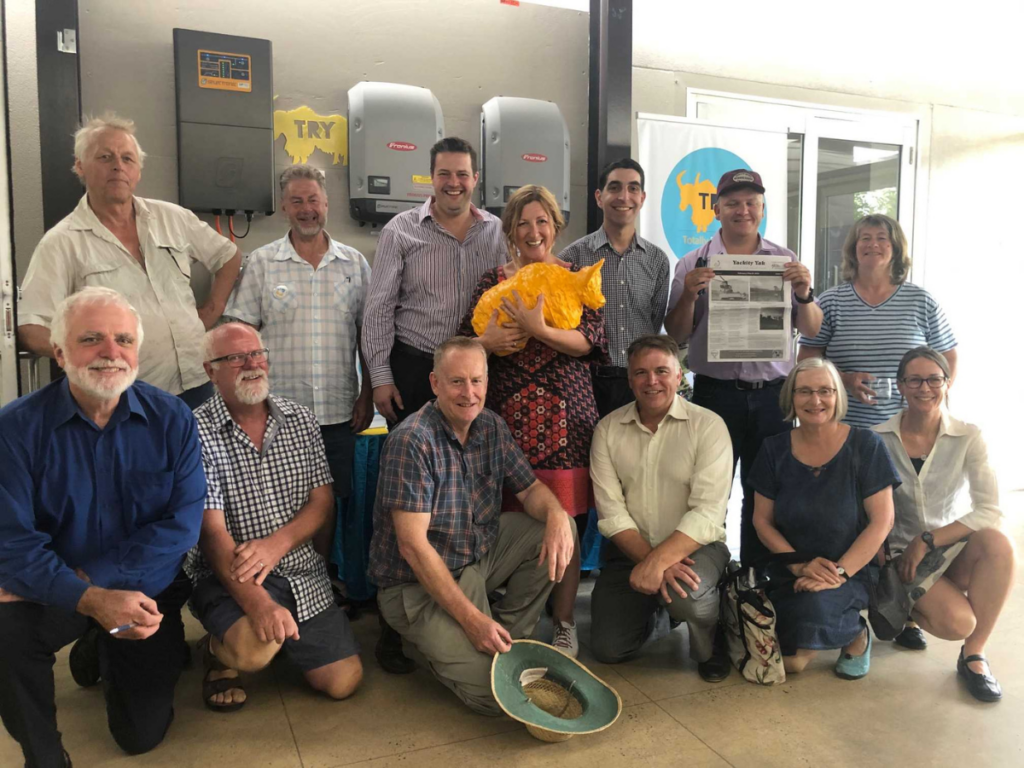
The grants can fund community-driven projects that educate and engage local people to reduce emissions, adopt clean energy practices, low carbon power sources, and embrace reuse and regenerative practices. Funding can also support solutions that deliver sustainable agriculture and food systems, biodiverse ecosystems, or activities designed to maintain the livelihoods of people reliant on industries in transition.
Sarah Matthee, General Manager, Partnerships & Services at FRRR, said many rural communities are eager to capitalise on cleaner and more sustainable climate solutions but often have limited access to funding or simply don’t have the capacity to investigate options.
“By offering flexible funding that is focused on community-led climate solutions, we want to enable NFPs to develop local solutions that respond to and mitigate the impacts of a changing climate in a way that is meaningful and responsive to the needs their community.
“Thanks to generous seed funding from Boundless Earth and Hand Heart Pocket, there is more than $300,000 available across the coming rounds of the Community Led Climate Solutions program. Our donor partners are committed to funding community-led solutions that reduce emissions and address the impacts of climate change and we are pleased to be working with them to fund local initiatives that will help drive positive and sustainable environmental, social and economic outcomes for rural Australia. We welcome further contributions to this collaborative pool to grow the impact that can be generated across rural Australia.
“In terms of examples of what the program can fund, there are several initiatives that FRRR has previously supported, which we think could inspire other communities. For example, Augusta Margaret River Clean Community Energy Incorporated received funding to undertake a dairy waste energy study, ahead of planning for an aggregated biogas and renewable power grid-connected facility. We’ve also funded free informative workshops on energy efficiency and renewable energy in small Victorian towns.
“You may have had a climate solutions project in mind for a long time but haven’t known where to go for support. We encourage people to think outside the box, reflecting on what your community needs most, to address and mitigate the impacts of climate change,” Ms Matthee said.
Applications for the Community Led Climate Solutions program close Thursday, 30 November 2023 at 5 pm AEDT. More information can be found at frrr.org.au/community-led-climate-solutions/.
In this quarter’s update for FRRR’s partners and supporters, we’re looking at how fundraising accounts, community foundations and small grants can enable grassroots groups to tackle local priorities, like Mparntwe Alice Springs Community Foundation – a new group whose first project was to bring back a printed weekly newspaper for the community! Also in this edition:
- read about the high value and high demand for our Small Grants programs
- learn about Engawala Art Centre’s journey to developing a physical space for painters
- Insights from FRRR’s team as network, travel and deliver programs
- Our Progress – Q4 FY 2022/23
- Partnering opportunities to activate great projects

It’s no secret that risks presented by our changing climate loom large. The communities FRRR serves are particularly vulnerable to the impacts of increasingly frequent and severe natural disasters and climate extremes. These impacts threaten to exacerbate existing social and economic inequalities, and negatively affect the liveability – and therefore the sustainability – of these communities.
As the Australian Government’s 2022 climate change statement noted:
“Our weather is becoming increasingly variable. More frequent extreme and cascading weather events are impacting our communities and economy, disrupting lives, and threatening our environment. At the same time, summers are becoming steadily hotter and drier, leading to adverse health impacts, increased bushfire risks and ecological damage, and threatening agricultural production. We must anticipate, prepare for and adapt to the impacts from our warming climate. Second, we must mitigate further catastrophic climate change by reducing our own emissions and playing a leadership role in supporting other nations to reduce theirs. Both will require an economic transformation on a scale beyond anything we have experienced in our lifetimes.“
While FRRR has seen an increase in applications we receive that are focused on disaster preparedness efforts, there has been markedly less focus on embracing practices and solutions that reduce the impact of the changing climate or capitalise on opportunities. Often this isn’t for want of great ideas, but rather limited access to funding and capacity to investigate options, particularly for not-for-profit (NFP) groups who want to be proactive and undertake community-led projects.
That’s why, with the support of generous seed funders, we are launching a Community-led Climate Solutions program. We’ve seen time and again that when we can offer dedicated funding around a particular issue – such as In a Good Place (targeting mental health) and Telstra Connected Communities (targeting the digital divide), amazing things happen. All too often it only takes relatively modest funding, backed by volunteers, to bring these projects to life.
So, we intend to offer funding to NFP groups twice a year to help them leverage the incredible knowledge, innovation and commitment in rural areas to implement locally-led climate solutions. The grants will aim to support three key areas:
- Drive engagement, education, and leadership in remote, rural, and regional climate solutions;
- Activate locally-led opportunities to advance energy transition, climate adaptation, decarbonisation and circular economies; and
- Support just transitions to new clean economies for thriving communities.
These different objectives will allow community groups to take action that reflects the most pressing issues in their community, but also recognises that the conversation is unfolding in different ways, and at a different pace in different regions. Some will be ready to take bold action to capitalise on the opportunities from the transformation of our industrial sector, while others will need support to build understanding and drive engagement towards the prospect of a different future. We need initiatives that are designed by each community, that will work for their context.
The grants could potentially fund projects like these, which FRRR has previously supported:
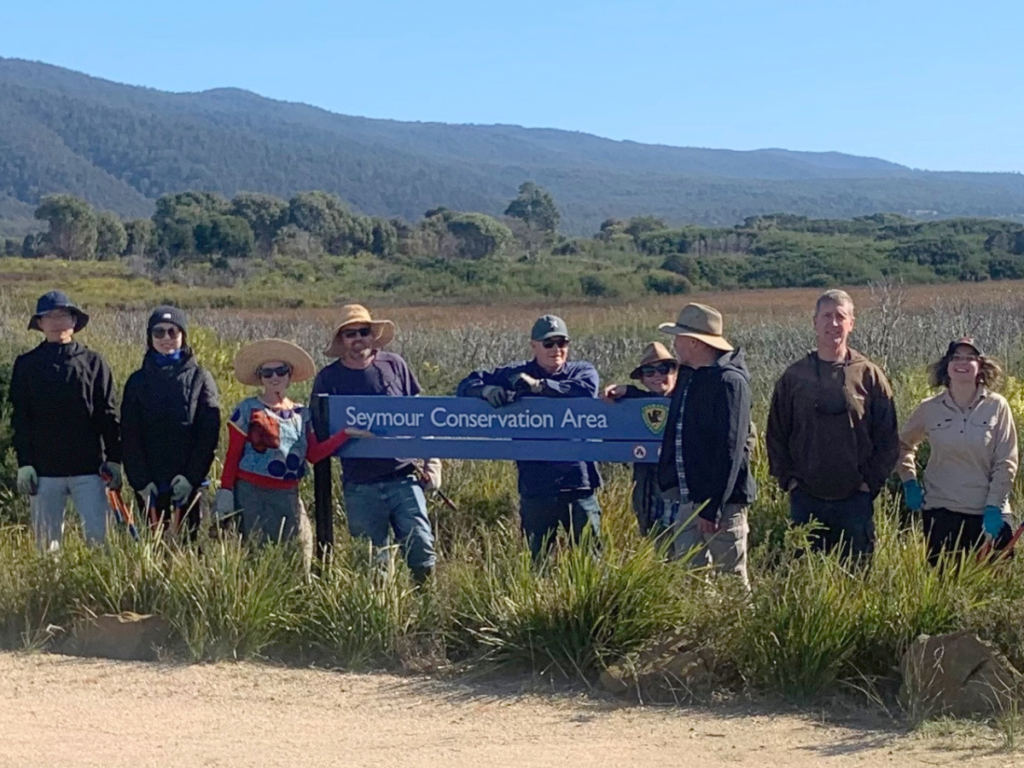
Seymour Community Wetland Restoration & Reclassification Project, TAS
A $10,000 grant was awarded from FRRR (proudly supported by IKEA) to fund weed control and restoration of the Seymour Wetland Reserve (including workshops on Seed Collection, Propagation and Restoration). The work of the volunteers, together with professional support from this funding, resulted in the Reclassification of the project area in June 2022, to double the size of the Seymour Conservation Area, contributing to restoration of native species (over 650 trees have been planted by the group) and decarbonisation. The media exposure from the Reclassification attracted new members and enrolled others in the community to become more active in the Conservation area.

Bendigo Sustainability Group, Regional Community Energy Workshops, VIC
The Bendigo Sustainability Group (BSG) has been operating for 10 years. Over that period, BSG has been involved in the successful delivery of a wide range of projects and programs, creating awareness around sustainable living, renewable energy options, climate change and the need for decarbonisation.
This $10,000 grant funded by FRRR, with the support of the Community Foundation for Central Victoria, has enabled BSG to deliver free, engaging and informative workshops on energy efficiency and renewable energy in small towns throughout the Loddon Mallee region. As a result, they have also been able to identify and support the development of community renewable energy projects to enhance the resilience of these communities.
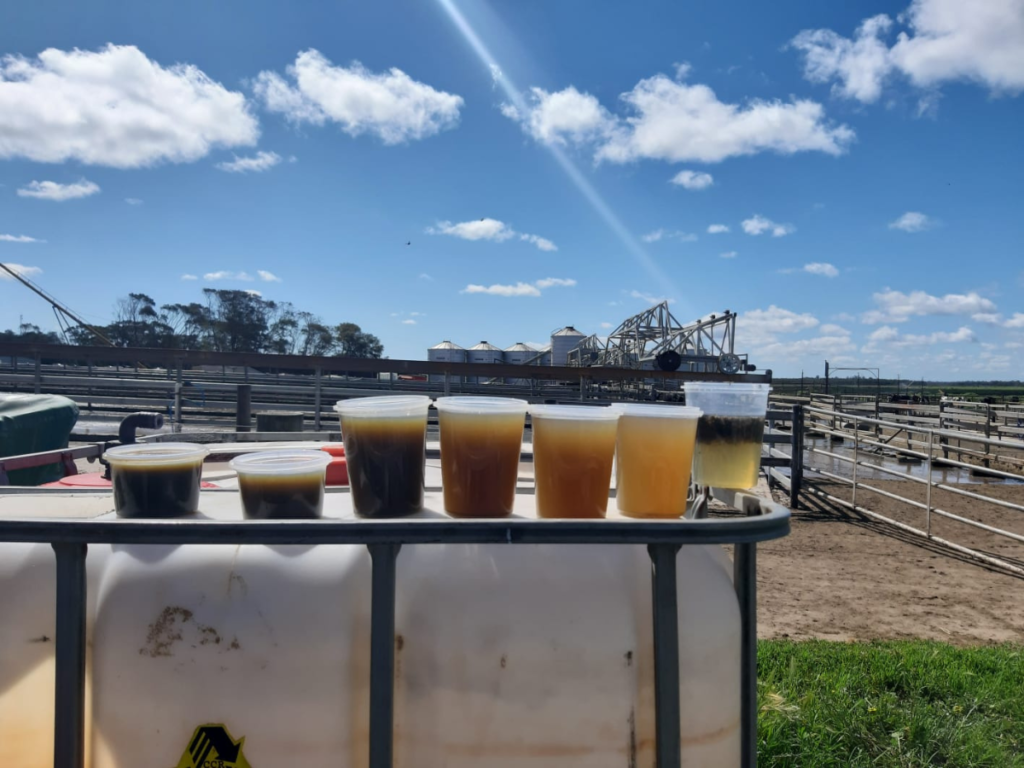
Augusta Margaret River Clean Community Energy Incorporated, WA
The Dairy Waste Energy Study project was part of Shire of Augusta-Margaret River’s ambitious plan to operate at net zero carbon emissions by 2030. AMRCCE wanted to investigate creating biogas from dairy manure waste, while also diverting effluent from nearby water sources. The project utilised an FRRR grant to partially fund the study, which assessed the Butane Methane Potential contained in dairy waste from a large dairy farm in the Scott River area in the Augusta Margaret River local government area. It was an important precursor to the planning and development of what could be an aggregated biogas and renewable power grid connected facility, and was involved in a PhD study and associated scientific paper.
More than money
In addition to the funding, grantees will have access to FRRR’s capacity building expertise and guidance, to help them shape their projects and, in time, we will also seek to connect these groups to leverage learnings across communities. We’re also keen to connect these organisations with businesses who may be able to provide one-off or ongoing pro-bono support. This program will also focus attention and promote conversations to catalyse additional community-led solutions.
Further, by analysing application data and by tracking impacts, FRRR will be able to generate insights into how communities are activating climate solutions and identify what additional support may be required, or what barriers NFP groups are facing.
Join us?
Thanks to generous seed funders, FRRR is set to launch the program’s first round at the end of October 2023, but we know this program will be in high demand, so we’re looking for additional partners to walk alongside us and enable rural communities to access climate solutions focused funding well into the future.
If this is something you are interested in learning more about, please contact either Sarah Matthee or Jillian Kirwan-Lee via partnerships@frrr.org.au.

